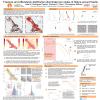Poster #139, Fault and Rupture Mechanics (FARM)
Diverse stress state evolutions of induced earthquake sequences in Oklahoma revealed through high resolution focal mechanism solutions
Poster Image:

Poster Presentation
2020 SCEC Annual Meeting, Poster #139, SCEC Contribution #10586 VIEW PDF
ds: the waveform-correlation derived relative polarities (Shelley et al., 2016) and a deep learning polarity classification model (Ross et al., 2018). The results show that the main fault structures in Cushing and Fairview are near-vertical strike-slip faults, and over 80% of the small earthquakes are optimally oriented to the regional stress field. In contrast, Guthrie and Woodward sequences show more complex structures. In Guthrie, the main fault is vertical at shallow depth and dipping at 60˚ to the northeast at deeper depth. In Woodward, the main fault is characterized by a flower structure with decreasing dipping angles at shallower depth. The inverted focal mechanisms show a mix of strike-slip faulting and normal faulting in both sequences. The percentage of optimally oriented events is 78% and 66% for Guthrie and Woodward. All four sequences tend to initiate with optimally oriented events, and then some less- or non-optimally oriented events occur later following larger events in the sequence, which suggests the influence of processes other than injection, such as earthquake interactions. The results could explain the differences in temporal seismicity evolutions in the four sequences. In Cushing and Fairview, the relatively simple main faults combined with more optimally oriented events result in maximum magnitudes larger than 5.0. However, in Guthrie and Woodward, a more complex fault plane and fewer optimally oriented events form typical swarm-type sequences without significant change in earthquake magnitude and seismicity rate. Our results reflect the heterogenous fault structures and focal mechanisms in Oklahoma, which possibly influence the seismicity evolution and earthquake hazards in different sequences.
SHOW MORE
SHOW MORE


























































